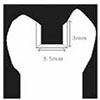Abstract
The purpose of present study was to evaluate the polymerization shrinkage stress and cuspal deflection in maxillary premolars resulting from polymerization shrinkage of composites and compomers.
Composites and compomers which were used in this study were as follows: Dyract AP, Z100, Surefil, Pyramid, Synergy Compact, Heliomolar, Heliomolar HB, and Compoglass F. For measuring of polymerization shrinkage stress, Stress measuring machine (R&B, Daejon, Korea) was used. One-way ANOVA analysis with Duncan's multiple comparison test were used to determine significant differences between the materials.
For measuring of cuspal deflection of tooth, MOD cavities were prepared in 10 extracted maxillary premolars. And reduction of intercuspal distance was measured by strain measuring machine (R&B, Daejon, Korea) One-way ANOVA analysis with Turkey test were used to determine significant differences between the materials.
Polymerization shrinkage stress is 『Heliomolar, Z100, Pyramid < Synergy Compact Compoglass F < Dyract AP < Heliomolr HB, surefil』 (P < 0.05). And cuspal delfelction is 『Z100, Heliomolar, Heliomolar HB, Synergy Compact Surefil, < Compoglass F < Pyramid, Dyract AP』 (P < 0.05).
Measurements of ploymerization shrinkage stress and those of cuspal deflection of the teeth was different. There is no correlation between polymerization shrinkage stress and cuspal deflection of the teeth (p > 0.05).
Figures and Tables
References
1. Baush JR, de Lange K, Davidson CR, Peters A, De Gee AJ. Clinical significance of polymerization shrinkage of composite resins. J Prosthet Dent. 1982. 48:59–67.

2. Eick JD, Welch FH. Polymerization shrinkage of posterior composites resins and its possible influence on postoperative sensitivity. Quintessence Int. 1986. 17:103–111.
3. Kemp-Scholte CM, Davidson CL. Marginal sealing of curing contractions gaps in class V composite resin restorations. J Dent Res. 1988. 67:841–845.

4. Robert JC, Powers JM, Craig RG. Fracture toughness of composite and unfilled restorative resins. J Dent Res. 1977. 56:748.

5. Feilzer AJ, De Gee AJ, Davidson CL. Setting stress in composite resin in relation to configuration of the restoration. J Dent Res. 1987. 66:1636–1639.

6. Feilzer AJ, De Gee AJ, Davidson CL. Increased wall to wall curing contraction in thin bonded resin layers. J Dent Res. 1989. 68:48–50.

7. Hansen EK. Effect of cavity depth and application technique on marginal adaptation of resins in dentin cavities. J Dent Res. 1986. 65(11):1319–1321.

8. Krejci I, Sperr D, Lutz F. A three-sited light curing technique for conventional Class II composite restoraions. Quintessence Int. 1987. 38:125–131.
9. Lutz F, Krejci I, Barbakow F. The importance of proximal curing in posterior composite resin restorations. Quintessence Int. 1992. 23:605–607.
10. Krejci I, Lutz F. Marginal adaptation of class V restorations using different restorative technique. J Dent. 1991. 19:24–32.

11. McCullock AJ, Smith B. In vitro studies of cuspal movement produced by adhesive materials. Br Dent J. 1986. 161:405–409.

12. Park SH, Krejci I, Lutz F. Consistency in the amount of linear polymerization shrinkage in syringe type composite. Dent Mater. 1999. 442–446.
13. Park SH, Krejci I, Lutz F. A comparison of microhardness of resin composites polymerized by plasma arc or conventional visible light curing. Oper Dent. 2002. 27:30–37.
14. Suliman AA, Boyer DB, Lakes RS. Cusp movement in premolars resulting from composite polymerization shrinkage. Dent Mater. 1993. 9:6–10.

15. Ericson D, Paulsson L, Sowaik H, Derand T. Reduction of cusp deflection resulting from composite polymerization shrinkage, using a light-transmitting cone. Scand J Dent Res. 1994. 102:244–248.

16. Park SH, Kim SS, Cho YS, Lee SY, Kim DH, Jang YJ, Mun HS, Seo JW, Noh BD. Amount of polymerization shrinkage stress in composites and compomers for posterior restoration. J Korean Acad Conserv Dent. 2003. 28:354–359.





 PDF
PDF ePub
ePub Citation
Citation Print
Print













 XML Download
XML Download